Arizona Metals Corp’s Kay Mine Drilling Intersects 68.4 m at 6.7 g/t AuEq; 84.4 m at 5.3 g/t AuEq; and 72.5 m at 2.5% CuEq
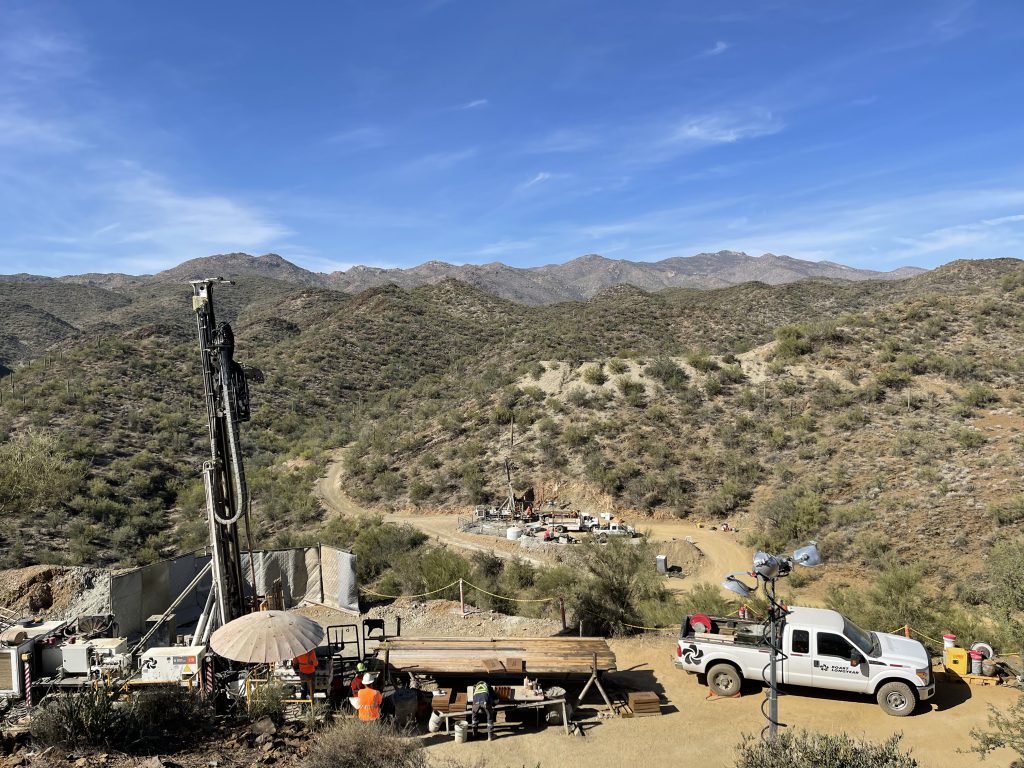
Arizona Metals Corp. (TSX.V:AMC, OTCQX:AZMCF) (the “Company” or “Arizona Metals”) is pleased to announce the results of six recently completed drill holes at its Kay Mine project in Yavapai, County Arizona. An additional 20 holes are pending, with three drill rigs turning 24 hours per day.
Marc Pais, CEO, commented “Drilling at the Kay Mine Project continues to intersect very large widths and high grades of massive sulphide mineralization. The holes released today demonstrate excellent continuity of mineralization in all directions, while also showing that mineralization is substantially thicker than suggested by our original modelling. Drilling has extended mineralization well into both the hanging-wall and foot-wall envelopes, which gives the potential to define a significant tonnage of mineralization.
Hole 51B showed the deepest mineralization assayed to date, at a vertical depth of 900 meters. Drilling is currently underway to test for depth extensions to at least 1,100 meters, while also testing for lateral extensions of the thick hinge zone. The twenty holes pending all encountered semi-massive or massive sulphide mineralization, and those intersections are guiding the drilling currently underway.
We have drilled approximately 45,000 meters at Kay to date, with each hole solidifying our opinion that this is one of the very few large precious-metals rich VMS deposits not yet mined, and more importantly, is potentially part of a much larger mineralized system that has yet to be explored. To that end, we recently completed a property-wide ground-loop electromagnetic survey, which will serve to refine and improve the resolution of the Central and Western targets, located approximately 300 meters and 1,000 meters west of Kay, respectively. Drill pad and road permitting is currently underway for these targets, with a detailed update expected in the next few weeks.

Figure 1. Cross section view looking north showing assay intervals in drilling. See Tables 1-3 for additional details. The true width of mineralization is estimated to be 50% to 99% of reported core width, with an average of 80%.

Figure 2. Cross section view looking north showing assay intervals in drilling. See Tables 1-3 for additional details. The true width of mineralization is estimated to be 50% to 99% of reported core width, with an average of 80%. See Table 1 for constituent elements, grades, metals prices and recovery assumptions for AuEq g/t calculations. Analyzed Metal Equivalent calculations are reported for illustrative purposes only.
Drilling Highlights
- Hole KM-21-58 intersected 4 m at a grade of 6.7 g/t AuEq, including higher-grade intervals of 7.3 m grading 10.1 g/t AuEq and 10.5 m grading 21.1 g/t AuEq, from a depth of 614 m. This hole is in the central portion of the deposit, and demonstrates excellent continuity of mineralization between holes 26, 28, 25A, and 40.
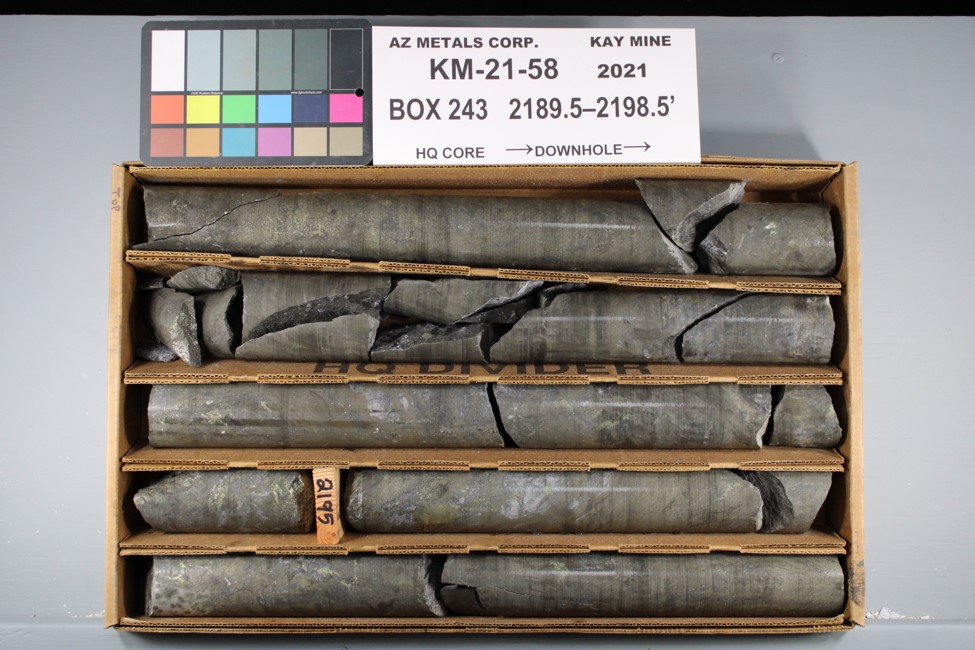
Figure 3. Hole KM-21-58 displaying interval from 667.8 m to 670.5 m downhole, intersecting 1.5 m grading 43.2 g/t Au, 2.6% Cu, 7.8% Zn, and 856 g/t Ag. This is part of a broader 68.4 m interval, from 614.2 m to 682.6 m, grading 6.7 g/t AuEq. See Table 1 for constituent elements, grades, metals prices and recovery assumptions for AuEq g/t calculations. Analyzed Metal Equivalent calculations are reported for illustrative purposes only.
- Hole KM-21-58A intersected5 m at a grade of 2.5% CuEq, including higher grade intervals of 7.6 m grading 3.0% CuEq, 11.0 m grading 4.3% CuEq, and 8.3 m grading 4.2% CuEq, from a depth of 569 m. This hole is in the central portion of the deposit, and demonstrates continuity and extension of mineralization between holes 26, 28, 25A, and 40.
- Hole KM-21-58B intersected 4 m at a grade of 5.3 g/t AuEq, including higher grade intervals of 11.3 m grading 10.3 g/t AuEq, and 17.4 m grading 11.2 g/t AuEq, from a depth of 597 m. This hole is in the central portion of the deposit, and demonstrates continuity of mineralization between holes 26, 28, 25A, and 40.
- Hole KM-21-51B intersected 8 m at a grade of 2.8% CuEq, including a higher grade interval of 0.9 m grading 8.0% CuEq, from a depth of 861m. At 10.6 m farther down-hole, this hole also intersected 9.8 m grading 1.4% Cu, including 1.1 meters grading 6.1% CuEq. This is the deepest hole assayed to date, extending mineralization about 35 m north and 12 m downdip from hole 42C.
- Hole KM21-57 intersected 8 m grading 3.9 g/t AuEq, including a higher grade interval of 0.9 m at a grade of 12.7 g/t AuEq, from a depth of 820 m. Thirty-five meters farther downhole, this hole intersected 15.5 m at a grade of 3.3% CuEq including a higher grade interval of 3.5 m grading 7.5% CuEq. This hole shows excellent continuity of high-grade mineralization between holes 27A and 42A.
Kay Mine Phase 2 Drill Program Update
With the assayed holes released today, the Company has completed a total of 45,000 meters at the Kay Mine since inception of drilling. The Company is fully-funded to complete the remaining 30,000 meters planned for the Phase 2 program, as well as an additional 76,000 meters in the upcoming Phase 3 program.
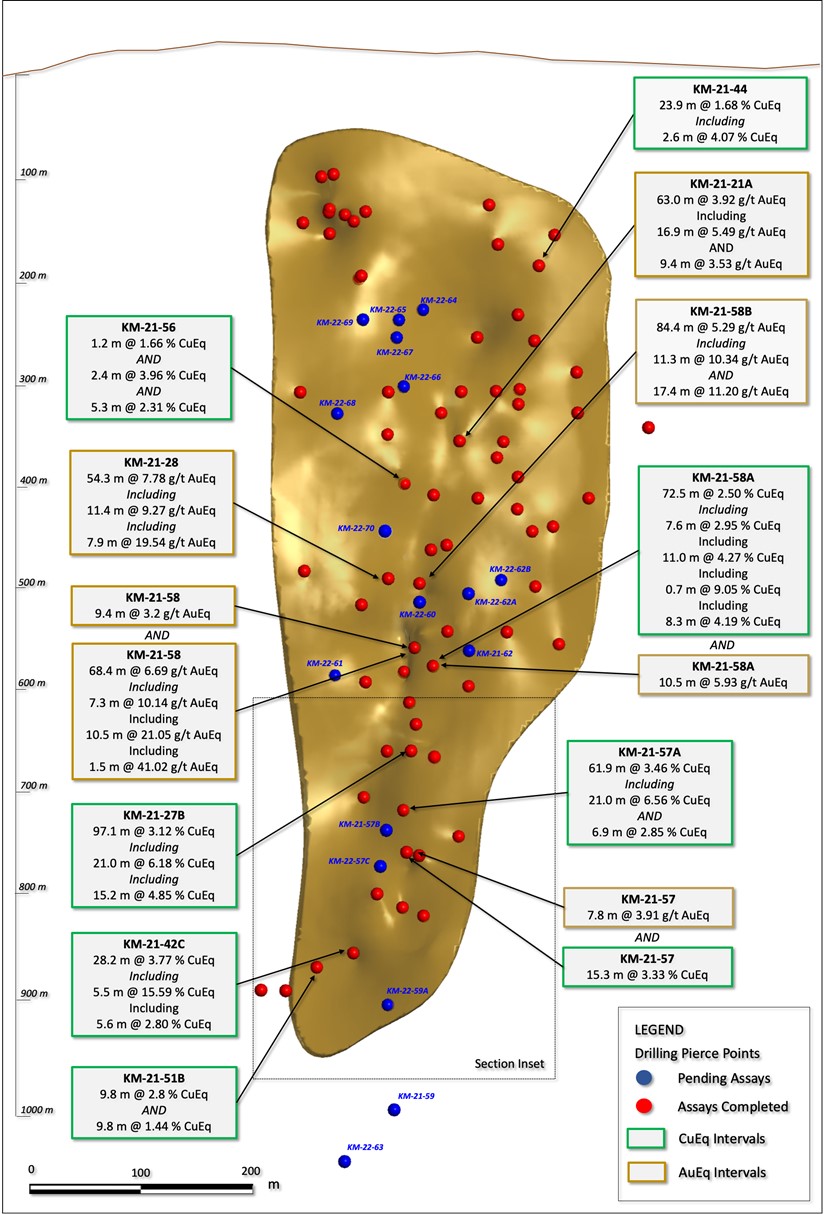
Figure 4. Long section displaying Kay Mine drill holes. See Tables 1-3 for additional details. The true width of mineralization is estimated to be 50% to 99% of reported core width, with an average of 80%. See Table 1 for constituent elements, grades, metals prices and recovery assumptions used for AuEq g/t and CuEq % calculations. Analyzed Metal Equivalent calculations are reported for illustrative purposes only.
Table 1. Results of Phase 2 Drill Program at Kay Mine, Yavapai County, Arizona announced in this news release.
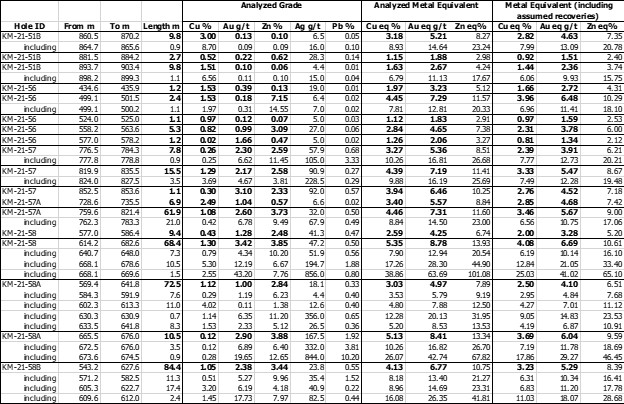
The true width of mineralization is estimated to be 50% to 99% of reported core width, with an average of 80%. (2) Assumptions used in USD for the copper and gold Metal Equivalent calculations were metal prices of $4.63/lb Copper, $1937/oz Gold, $25/oz Silver, $1.78/lb Zinc, and $1.02/lb Pb. Assumed metal recoveries (rec.), based on a preliminary review of historic data by SRK and ProcessIQ[1], were 90% for each of copper, zinc, and lead, and 60% for each of gold and silver. The following equation was used to calculate copper equivalence: CuEq = Copper (%) (90% rec.) + (Gold (g/t) x 0.61)(60% rec.) + (Silver (g/t) x 0.0079)(60% rec.) + (Zinc (%) x 0.3844)(90% rec.) +(Lead (%) x 0.2203)(90% rec.). The following equation was used to calculate gold equivalence: AuEq = Gold (g/t)(60% rec.) + (Copper (%) x 1.638)(90% rec.) + (Silver (g/t) x 0.01291)(60% rec.) + (Zinc (%) x 0.6299)(90% rec.) +(Lead (%) x 0.3609)(90% rec.). Analyzed Metal Equivalent calculations are reported for illustrative purposes only. The metal chosen for reporting on an equivalent basis is the one that contributes the most dollar value after accounting for assumed recoveries.
[1] SRK Consulting (Canada) Inc., November 2020, Metallurgical Review, Kay Mine, Arizona. Report 5CS017.000
Table 2. Full results of Phase 2 Drill Program at Kay Mine, Yavapai County, Arizona.
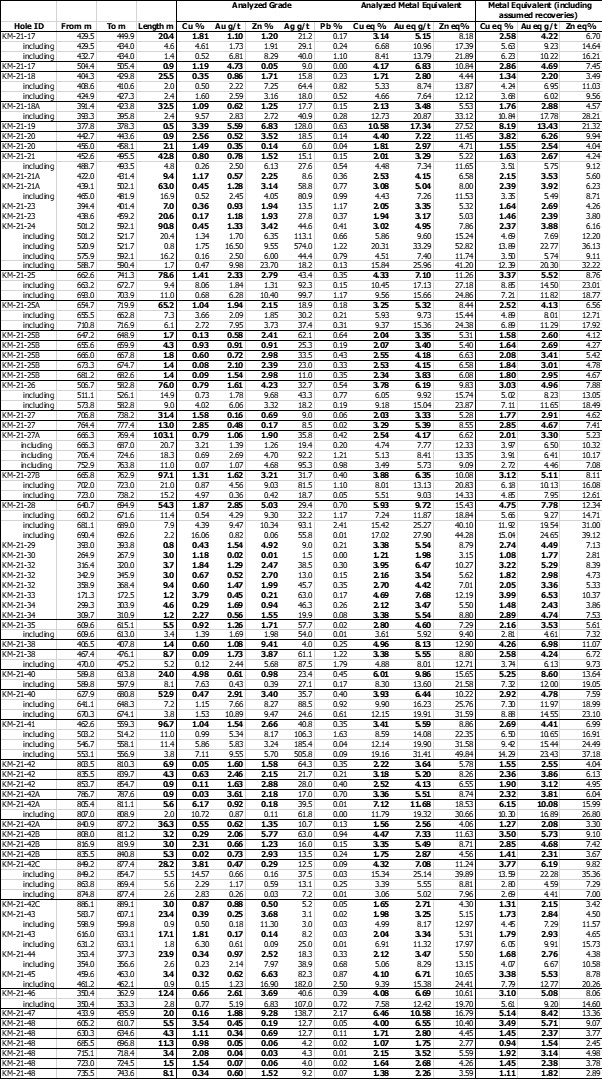
The true width of mineralization is estimated to be 50% to 99% of reported core width, with an average of 80%. (2) Assumptions used in USD for the copper and gold Metal Equivalent calculations were metal prices of $4.63/lb Copper, $1937/oz Gold, $25/oz Silver, $1.78/lb Zinc, and $1.02/lb Pb. Assumed metal recoveries (rec.), based on a preliminary review of historic data by SRK and ProcessIQ[1], were 90% for each of copper, zinc, and lead, and 60% for each of gold and silver. The following equation was used to calculate copper equivalence: CuEq = Copper (%) (90% rec.) + (Gold (g/t) x 0.61)(60% rec.) + (Silver (g/t) x 0.0079)(60% rec.) + (Zinc (%) x 0.3844)(90% rec.) +(Lead (%) x 0.2203)(90% rec.). The following equation was used to calculate gold equivalence: AuEq = Gold (g/t)(60% rec.) + (Copper (%) x 1.638)(90% rec.) + (Silver (g/t) x 0.01291)(60% rec.) + (Zinc (%) x 0.6299)(90% rec.) +(Lead (%) x 0.3609)(90% rec.). Analyzed Metal Equivalent calculations are reported for illustrative purposes only. The metal chosen for reporting on an equivalent basis is the one that contributes the most dollar value after accounting for assumed recoveries.
Table 2 Continued. Full results of Phase 2 Drill Program at Kay Mine, Yavapai County, Arizona. The true width of mineralization is estimated to be 50% to 99% of reported core width, with an average of 80%.
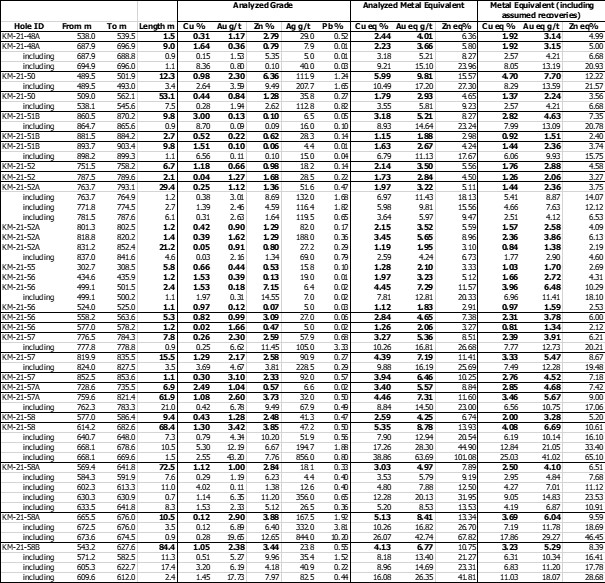
The true width of mineralization is estimated to be 50% to 99% of reported core width, with an average of 80%. (2) Assumptions used in USD for the copper and gold Metal Equivalent calculations were metal prices of $4.63/lb Copper, $1937/oz Gold, $25/oz Silver, $1.78/lb Zinc, and $1.02/lb Pb. Assumed metal recoveries (rec.), based on a preliminary review of historic data by SRK and ProcessIQ[1], were 90% for each of copper, zinc, and lead, and 60% for each of gold and silver. The following equation was used to calculate copper equivalence: CuEq = Copper (%) (90% rec.) + (Gold (g/t) x 0.61)(60% rec.) + (Silver (g/t) x 0.0079)(60% rec.) + (Zinc (%) x 0.3844)(90% rec.) +(Lead (%) x 0.2203)(90% rec.). The following equation was used to calculate gold equivalence: AuEq = Gold (g/t)(60% rec.) + (Copper (%) x 1.638)(90% rec.) + (Silver (g/t) x 0.01291)(60% rec.) + (Zinc (%) x 0.6299)(90% rec.) +(Lead (%) x 0.3609)(90% rec.). Analyzed Metal Equivalent calculations are reported for illustrative purposes only. The metal chosen for reporting on an equivalent basis is the one that contributes the most dollar value after accounting for assumed recoveries.
Table 3. Results of Phase 1 Drill Program at Kay Mine, Yavapai County, Arizona. The true width of mineralization is estimated to be 50% to 99% of reported core width, with an average of 80%.
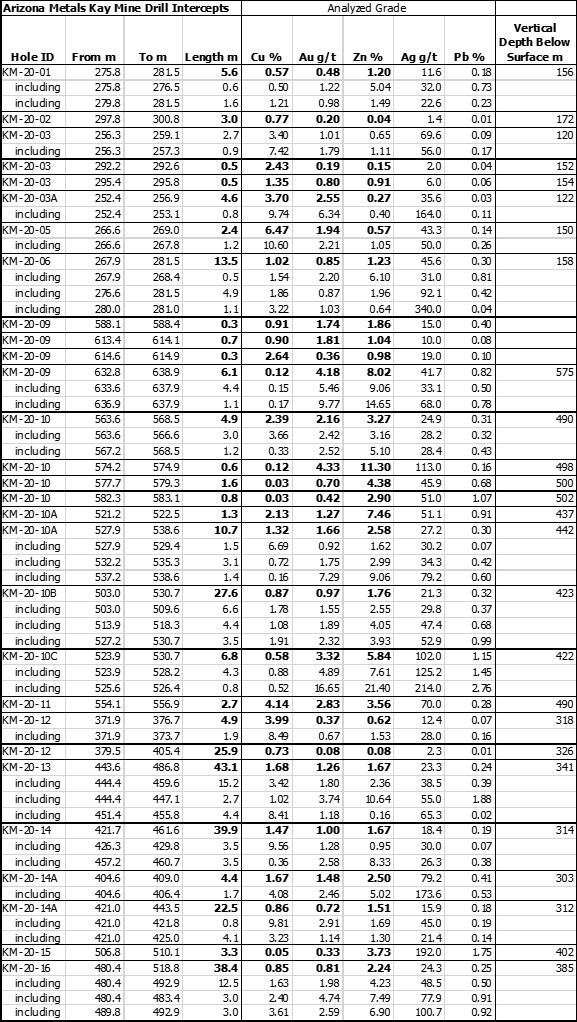
[1] SRK Consulting (Canada) Inc., November 2020, Metallurgical Review, Kay Mine, Arizona. Report 5CS017.000
[1] SRK Consulting (Canada) Inc., November 2020, Metallurgical Review, Kay Mine, Arizona. Report 5CS017.000
Table 4. Locations of Phase 1 and 2 Program drill holes completed at Kay Mine, Arizona

Covid-19 Monitoring and Mitigation Procedures
The Company’s drill contractor, Boart Longyear, has instituted Covid-19 monitoring procedures for all drill crew members, including daily temperature and symptom checks. Arizona Metals Corp will be provided with daily health tracking updates for the drill crews and has also instituted its own social distancing policies and provided a guidance manual for employees at site.
About Arizona Metals Corp
Arizona Metals Corp owns 100% of the Kay Mine Property in Yavapai County, which is located on a combination of patented and BLM claims totaling 1,300 acres that are not subject to any royalties. An historic estimate by Exxon Minerals in 1982 reported a “proven and probable reserve of 6.4 million short tons at a grade of 2.2% copper, 2.8 g/t gold, 3.03% zinc, and 55 g/t silver.” (Fellows, M.L., 1982, Kay Mine massive sulfide deposit: Internal report prepared for Exxon Minerals Company, November 1982, 29 p.) The historic estimate at the Kay Mine was reported by Exxon Minerals in 1982. The historic estimate has not been verified as a current mineral resource. None of the key assumptions, parameters, and methods used to prepare the historic estimate were reported, and no resource categories were used. Significant data compilation, re-drilling and data verification may be required by a “qualified person” (as defined in National Instrument 43-101 – Standards of Disclosure for Mineral Projects) before the historic estimate can be verified and upgraded to be a current mineral resource. A qualified person has not done sufficient work to classify it as a current mineral resource, and Arizona Metals is not treating the historic estimate as a current mineral resource.
The Kay Mine is a steeply dipping VMS deposit that has been defined from a depth of 60 m to at least 900 m. It is open for expansion on strike and at depth.
The Company also owns 100% of the Sugarloaf Peak Property, in La Paz County, which is located on 4,400 acres of BLM claims. Sugarloaf is a heap-leach, open-pit target and has a historic estimate of “100 million tons containing 1.5 million ounces gold” at a grade of 0.5 g/t (Dausinger, 1983, Westworld Resources).
The historic estimate at the Sugarloaf Peak Property was reported by Westworld Resources in 1983. The historic estimate has not been verified as a current mineral resource. None of the key assumptions, parameters, and methods used to prepare the historic estimate were reported, and no resource categories were used. Significant data compilation, re-drilling and data verification may be required by a qualified person before the historic estimate can be verified and upgraded to a current mineral resource. A qualified person has not done sufficient work to classify it as a current mineral resource, and Arizona Metals is not treating the historic estimate as a current mineral resource.
Qualified Person and Quality Assurance/Quality Control
All of Arizona Metals’ drill sample assay results have been independently monitored through a quality assurance/quality control (“QA/QC”) protocol which includes the insertion of blind standard reference materials and blanks at regular intervals. Logging and sampling were completed at Arizona Metals’ core handling facilities located in Anthem and Black Canyon City, Arizona. Drill core was diamond sawn on site and half drill-core samples were securely transported to ALS Laboratories’ (“ALS”) sample preparation facility in Tucson, Arizona. Sample pulps were sent to ALS’s labs in Vancouver, Canada, for analysis.
Gold content was determined by fire assay of a 30-gram charge with ICP finish (ALS method
Au-AA23). Silver and 32 other elements were analyzed by ICP methods with four-acid digestion (ALS method ME-ICP61a). Over-limit samples for Au, Ag, Cu, and Zn were determined by ore-grade analyses Au-GRA21, Ag-OG62, Cu-OG62, and Zn-OG62, respectively.
ALS Laboratories is independent of Arizona Metals Corp. and its Vancouver facility is ISO 17025 accredited. ALS also performed its own internal QA/QC procedures to assure the accuracy and integrity of results. Parameters for ALS’ internal and Arizona Metals’ external blind quality control samples were acceptable for the samples analyzed. Arizona Metals is not aware of any drilling, sampling, recovery, or other factors that could materially affect the accuracy or reliability of the data referred to herein.
The qualified person who reviewed and approved the technical disclosure in this release is David Smith, CPG, a qualified person as defined in National Instrument43-101-Standards of Disclosure for Mineral Projects. Mr. Smith supervised the preparation of the scientific and technical information that forms the basis for this news release and has reviewed and approved the disclosure herein. Mr. Smith is the Vice-President, Exploration of the Company.  Mr. Smith supervised the drill program and verified the data disclosed, including sampling, analytical and QA/QC data, underlying the technical information in this news release, including reviewing the reports of ALS, methodologies, results, and all procedures undertaken for quality assurance and quality control in a manner consistent with industry practice, and all matters were consistent and accurate according to his professional judgement. There were no limitations on the verification process.
Disclaimer
This press release contains statements that constitute “forward-looking information” (collectively, “forward-looking statements”) within the meaning of the applicable Canadian securities legislation, All statements, other than statements of historical fact, are forward-looking statements and are based on expectations, estimates and projections as at the date of this news release. Any statement that discusses predictions, expectations, beliefs, plans, projections, objectives, assumptions, future events or performance (often but not always using phrases such as “expects”, or “does not expect”, “is expected”, “anticipates” or “does not anticipate”, “plans”, “budget”, “scheduled”, “forecasts”, “estimates”, “believes” or “intends” or variations of such words and phrases or stating that certain actions, events or results “may” or “could”, “would”, “might” or “will” be taken to occur or be achieved) are not statements of historical fact and may be forward-looking statements. Forward-looking statements contained in this press release include, without limitation, statements regarding drill results and future drilling and assays, the resumption of drilling and the effects of the COVID-19 pandemic on the business and operations of the Company. In making the forward- looking statements contained in this press release, the Company has made certain assumptions. Although the Company believes that the expectations reflected in forward-looking statements are reasonable, it can give no assurance that the expectations of any forward-looking statements will prove to be correct. Known and unknown risks, uncertainties, and other factors which may cause the actual results and future events to differ materially from those expressed or implied by such forward-looking statements. Such factors include, but are not limited to: availability of financing; delay or failure to receive required permits or regulatory approvals; and general business, economic, competitive, political and social uncertainties. Accordingly, readers should not place undue reliance on the forward-looking statements and information contained in this press release. Except as required by law, the Company disclaims any intention and assumes no obligation to update or revise any forward-looking statements to reflect actual results, whether as a result of new information, future events, changes in assumptions, changes in factors affecting such forward- looking statements or otherwise.
NEITHER THE TSX VENTURE EXCHANGE (NOR ITS REGULATORY SERVICE PROVIDER) ACCEPTS RESPONSIBILITY FOR THE ADEQUACY OR ACCURACY OF THIS RELEASE
Not for distribution to US newswire services or for release, publication, distribution or dissemination directly, or indirectly, in whole or in part, in or into the United States
For further information, please contact:
Marc Pais
President and CEO Arizona Metals Corp.
(416) 565-7689
mpais@arizonametalscorp.com
www.arizonametalscorp.com
https://twitter.com/ArizonaCorp
